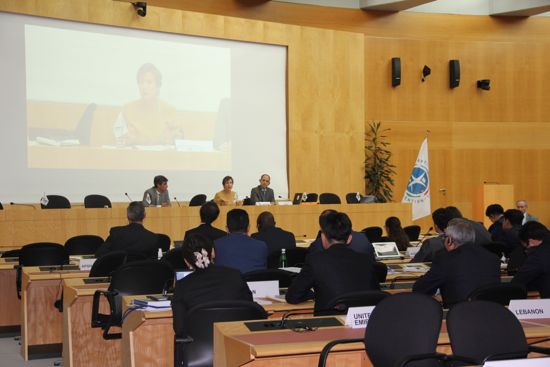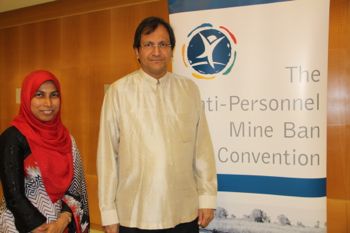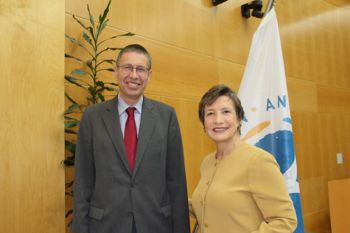20.05.2016

Download the press release
Geneva, 20 May 2016 – The Anti-Personnel Mine Ban Convention's permanent committees have concluded two days of work where matters related to treaty compliance and universal adoption of its norms, landmine clearance and survivors’ assistance were discussed and remaining challenges were identified.
Over 300 representatives of 75 States, international and non-governmental organisations attended the meeting at the UN's WMO in Geneva. Ambassador Marta Maurás of Chile as President of the treaty and the various working committees led the Convention's 2016 Intersessional Meetings.
"If there is one motivation for Chile to be engaged and involved in areas of disarmament, is our deep concern for a better humanity," said Ambassador Maurás.
"The prohibition of landmines and the humanitarian aims of this Convention are behind the actions of Chile in this Convention; in special, the foreseeable end of landmines by 2025. As Presidency, we wanted to follow up on the issues that were put into the Convention's plan of action two years ago. Chile wants to advance this agenda," said the Ambassador referring to the meeting in Geneva and the meeting of States Parties that Chile will convene at the end of the year in Santiago.
Some of the highlights from this two-day meeting included,
Clearing of all mined areas:
- Thirty (32) States Parties are still in the process of clearing mined areas.
- During the meeting Ecuador and Algeria indicated they are well on the road to meet their deadlines within the next year, further reducing the number of mine-affected countries in the world.
- Niger has requested a mine clearance extension until 2020.
- Peru, a State Party since 1999, has requested an additional eight years to finish mine clearance extending its 2017 deadline until 2025.
This is the second extension that Peru has presented since its original 2009 deadline. Peru has said that challenging environmental conditions, the discovery of new, larger minefields and budgetary constraints will prevent it from meeting next year's deadline. The additional clearance will cost an estimated 40 million USD which will be fully funded by the Peruvian government. - States Parties have asked Ukraine to submit a request for a mine-clearance extension after declaring that there are confirmed mined areas under its jurisdiction or control. Ukraine expressed it has started mine clearance operations in lands that are back under its control and that it is now providing mine-risk education to residents in mine-affected areas.
- Decisions on extension requests will be made at the 15MSP in December.
Destroying stockpiles:
- 158 of the 162 States Parties of the Convention no longer hold stocks; together these States Parties have destroyed over 48 million stockpiled landmines.
 |
Poland, with a 1 June 2017 deadline for destroying all stockpiled anti-personnel mines, indicated that it has destroyed over 1 million landmines and that about 17 thousand PSM-1 mines remain to be destroyed.
These landmines have been transported to Germany for destruction and the process will conclude in June 2016. |
- Belarus, Greece and Ukraine – for whom their deadlines have passed reported on their efforts,
- Greece reported that over 600,000 landmines remain. Greece has temporarily halted destruction efforts after a 1 October 2014 explosion at a destruction facility in Bulgaria killed 15 persons. Bulgaria no longer holds a destruction facility capable to destroy these dangerous mines and will now need to be sent to a new destruction facility. The remaining landmines will be sent to the Hellenic Defence Systems pending certification in accordance to international standards for safety and environmental compliance.
- Belarus, through a European Union-financed programme, has destroyed over 1.3 million PFM-1 mines. Belarus indicated that the project would be completed by the end of 2017.
- Ukraine indicated that it has destroyed almost 1.5 million landmines but that more than 5 million anti-personnel mines remain to be destroyed at a cost of nearly 4 million Euros for which it is receiving international assistance.
- Belarus and Ukraine face a particular challenge in needing to destroy millions of Soviet-era PFM-1 mines, which are extremely hazardous to people and the environment and pose serious technical difficulties.
Universal adoption of the Convention:

35 States have not yet ratified or acceded to the Convention. Combined, six of them – China, India, the Republic of Korea, Pakistan, Russia and the United States – may hold tens of millions of stockpiled antipersonnel mines.
Sri Lanka indicated it has officially started its process to ratify and accede to the Convention.
(R) Sri Lanka Ambassador Ravinatha Pandukabhaya Aryasinha
Next Meetings:

Ambassador Thomas Hajnoczi of Austria set to become the 16MSP President with Ambassador Marta Maurás, 15MSP President.
The Anti-Personnel Mine Ban Convention (or Ottawa Convention) was adopted in Oslo in 1997, opened for signature in Ottawa the same year and entered into force in 1999.
For more information contact the Convention's Implementation Support Unit (ISU) at: isu(at)apminebanconvention.org or call +41 22 730 9311.





